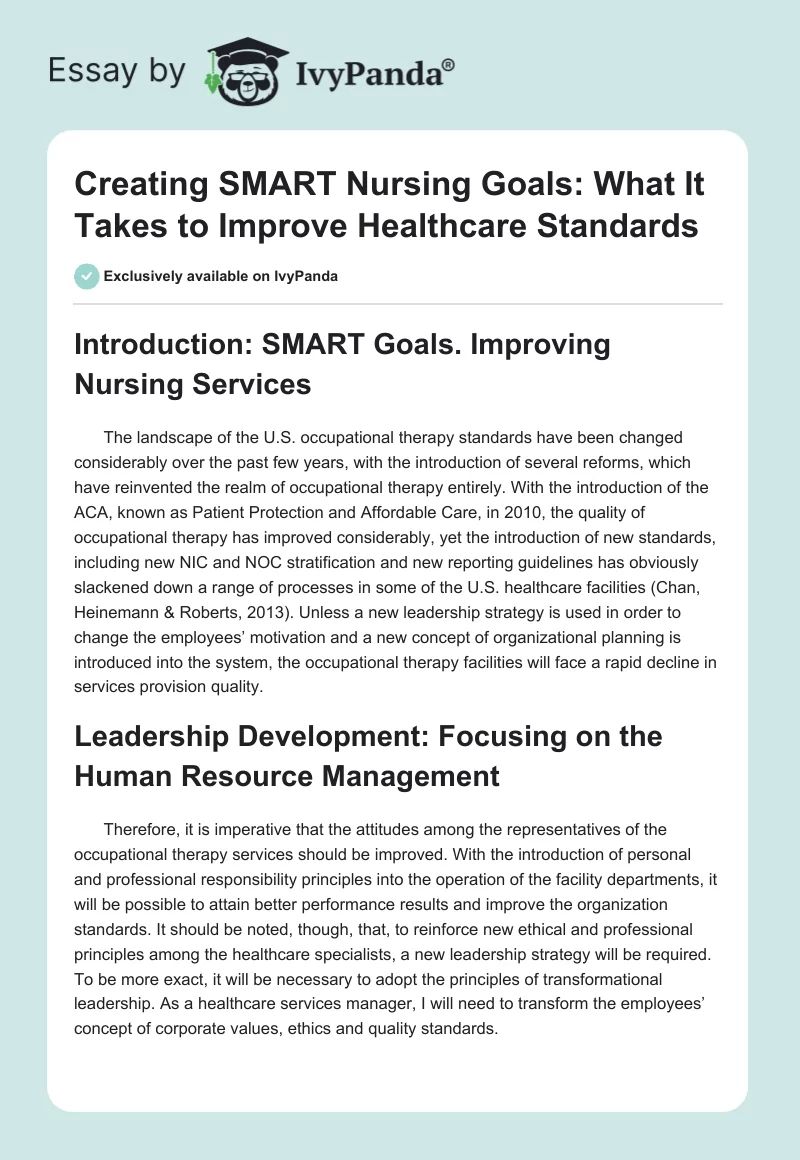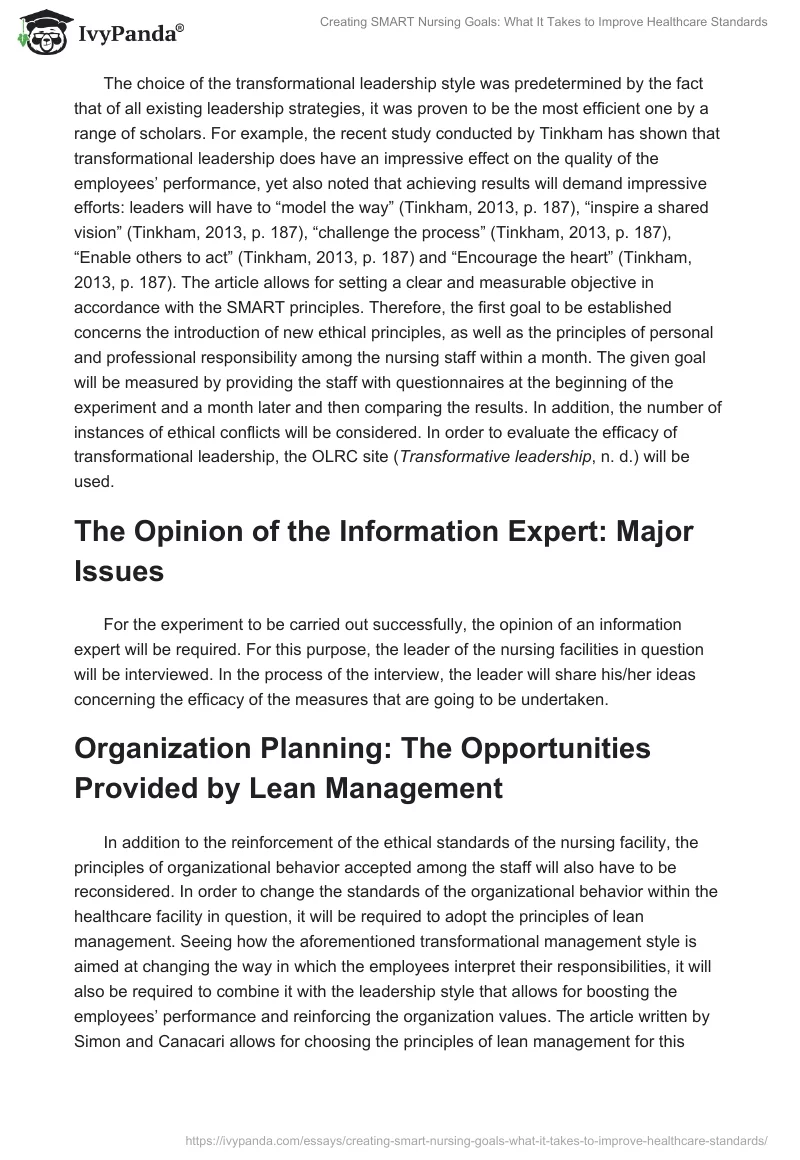- SMART Goals. Improving Nursing Services
- Leadership Development: Focusing on the Human Resource Management
- The Opinion of the Information Expert: Major Issues
- Organization Planning: The Opportunities Provided by Lean Management
- What the Information Expert Has to Say: Obstacles to Continuous Improvement
- Summary and Conclusion: What Needs to Be Done
- Reference List
SMART Goals. Improving Nursing Services
The landscape of the U.S. occupational therapy standards has changed considerably over the past few years, with several reforms that have reinvented the realm of occupational therapy entirely. With the introduction of the ACA, known as Patient Protection and Affordable Care, in 2010, the quality of occupational therapy has improved considerably.
Yet, introducing new standards, including new NIC and NOC stratification and new reporting guidelines, has slackened down a range of processes in some U.S. healthcare facilities (Chan, Heinemann & Roberts, 2013). Unless a new leadership strategy is used to change the employees’ motivation and a new concept of organizational planning is introduced into the system, occupational therapy facilities will face a rapid decline in service provision quality.
Leadership Development: Focusing on the Human Resource Management
Therefore, it is imperative that the attitudes among the representatives of the occupational therapy services should be improved. With the introduction of personal and professional responsibility principles into the operation of the facility departments, it will be possible to attain better performance results and improve the organization standards. It should be noted, though, that, to reinforce new ethical and professional principles among the healthcare specialists, a new leadership strategy will be required. To be more exact, it will be necessary to adopt the principles of transformational leadership. As a healthcare services manager, I will need to transform the employees’ concept of corporate values, ethics and quality standards.
The choice of the transformational leadership style was predetermined by the fact that of all existing leadership strategies, it was proven to be the most efficient one by a range of scholars. For example, the recent study conducted by Tinkham has shown that transformational leadership does have an impressive effect on the quality of the employees’ performance, yet also noted that achieving results will demand impressive efforts: leaders will have to “model the way” (Tinkham, 2013, p. 187), “inspire a shared vision” (Tinkham, 2013, p. 187), “challenge the process” (Tinkham, 2013, p. 187), “Enable others to act” (Tinkham, 2013, p. 187) and “Encourage the heart” (Tinkham, 2013, p. 187). The article allows for setting a clear and measurable objective in accordance with the SMART principles. Therefore, the first goal to be established concerns the introduction of new ethical principles, as well as the principles of personal and professional responsibility among the nursing staff within a month. The given goal will be measured by providing the staff with questionnaires at the beginning of the experiment and a month later and then comparing the results. In addition, the number of instances of ethical conflicts will be considered. In order to evaluate the efficacy of transformational leadership, the OLRC site (Transformative leadership, n. d.) will be used.
The Opinion of the Information Expert: Major Issues
For the experiment to be carried out successfully, the opinion of an information expert will be required. For this purpose, the leader of the nursing facilities in question will be interviewed. In the process of the interview, the leader will share his/her ideas concerning the efficacy of the measures that are going to be undertaken.
Organization Planning: The Opportunities Provided by Lean Management
In addition to the reinforcement of the ethical standards of the nursing facility, the principles of organizational behavior accepted among the staff will also have to be reconsidered. In order to change the standards of the organizational behavior within the healthcare facility in question, it will be required to adopt the principles of lean management. Seeing how the aforementioned transformational management style is aimed at changing the way in which the employees interpret their responsibilities, it will also be required to combine it with the leadership style that allows for boosting the employees’ performance and reinforcing the organization values. The article written by Simon and Canacari allows for choosing the principles of lean management for this purpose. Indeed, according to what Simon claims, lean management principles allow for enhancing corporate values among the staff to an impressive extent:
Value is enhanced by eliminating waste (i. e., any activity that does not add value) in the process; thus, quality, cost, and timeliness of delivered services can be improved and time made available to focus efforts on true value added activities. (Simon & Canacari, 2012, p. 86)
Speaking of the ways in which the changes within the organizational planning can be carried out, one must admit that surveys are not going to be of much help in this research design. Instead, it will be required to evaluate the performance of the staff alone and compare it to the performance rates before the application of the strategy in question. Consequently, it will be required to use a statistical analysis. The measurement units will be provided for each quality addressed in the test, e.g., the responsibility rates (%), the efficacy rates (%), etc. It can be assumed that the change of the nurses’ organizational behavior will be changed within a month. The official site of the NANDA standards (NANDA, n. d.) will be consulted in order to make sure whether the employees handle their responsibilities properly. Providing enough information concerning the requirements towards occupational therapists, NANDA.org can be considered an especially valuable resource.
What the Information Expert Has to Say: Obstacles to Continuous Improvement
In order to listen to an authoritative opinion concerning the lean management implementation effects, the viewpoint of the company’s leader will be considered once again. Another short interview with the organization’s CEO will help figure out whether the elan management concept has a potential.
Summary and Conclusion: What Needs to Be Done
It would be wrong to assume that the approaches mentioned above will immediately revolutionize the nursing system in general and the nursing facilities providing people with the occupational therapy related services in particular. Quite on the contrary, the process of acceptance of new leadership principle and a new concept of organizational planning is supposed to be rather long. Nevertheless, with the help of transformational leadership strategy, it will be possible to reinvent nursing specialists’ concept of quality performance by providing incentives and rewards and, thus, changing the employees’ motivation. Once the SMART goals are complied with and the objectives are met within the deadline set above, considerable improvements in the quality of nursing services in the field of occupational therapy can be expected.
As it has been suggested above, some of the nursing specialists will necessarily feel that the principles of new organizational behavior and nursing ethics are foisted onto them. Such attitudes can and will be changed with the help of transformation leadership principles. As soon as the employees’ motivation is changed, a rapid increase in quality can be expected.
Reference List
Chan, L., Heinemann, A. W. & Roberts, J. (2013). Elevating the quality of disability and rehabilitation research: Mandatory use of the reporting guidelines. Archives of Physical Medicine and Rehabilitation, 95(3), 415–417.
NANDA (n. d.). NANDA-I NIC NOC for safe patient care. Web.
Simon, R. W. & Canacari, E. G. (2012). A practical guide to applying lean tools and management principles to health care improvement projects. AORN Journal, 95(1), 85–103.
Tinkham, M. R. (2013). The road to magnet: Encouraging transformational leadership. AORN Journal, 98(2), 186–188.
Transformative leadership(n. d.). Web.


